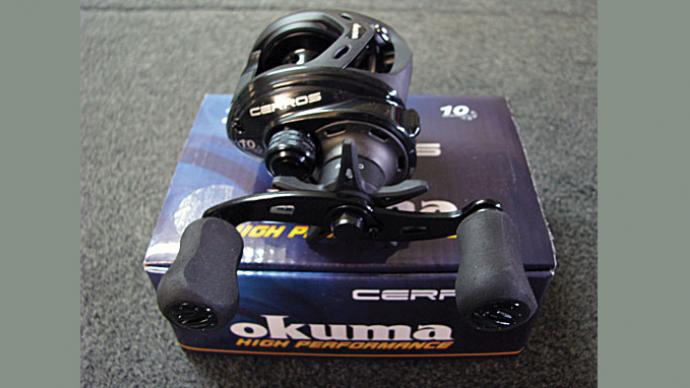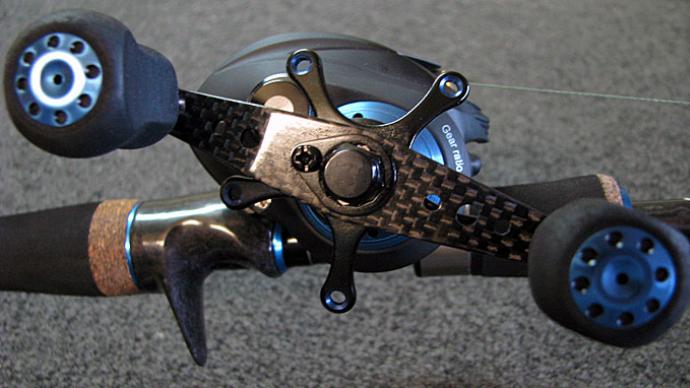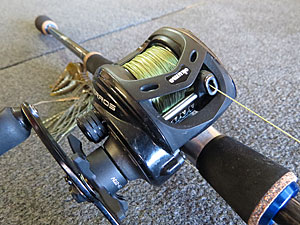
Like his father Roland, Pro Angler Scott Martin has competed on the highest levels of tournament angling. Scott’s experiences on the tournament trail and his work with Okuma have resulted in a series of bass rods that stand up to the rigors of professional tournament fishing and pass muster with us picky, weekend warrior types. Best of all, these rods will not break the bank. I cannot imagine being a rod designer, working within those restraints, and thinking of useful features many quality tackle makers ignore. More on that later.
I picked out a monster of a stick to reviewing for you guys. It’s extra heavy power, moderately fast action rod that measures nearly eight feet long. It’s called the Mat Daddy. I love the name, though it doesn’t tell the entire story of this rod. It’s not just a flipping rod, to be sure. It can handle quite a few things thrown at it.
The rod is simply a beast. Its forte is throwing Texas-rigged plastics and big jigs into heavy cover – and pulling out big fish. The rod is deceptively light, and at times I wondered if it was up to the task. I never felt outgunned, even in bushes, submerged trees, and thick reeds I like to fish. The rod is so light it didn’t feel like I was using a flipping stick. It’s a far cry from the rod I have been using the past few years that weighs as much as a brick.
What else can the Okuma Tournament Concept TCS-C-7111XH do? Well, it’s got a moderate fast action, though the tip feels faster when casting. That big flex takes quite a bit of load before it digs in. This helps absorb the shock of a strong hookset on braid line but still has that “lift and separate” power in reserve to wrench a big fish out of cover. Once under a load of a fish, all that resistance is spread across the blank, keeping the fish pinned and under control. This is a long rod, and I felt the leverage and power advantage as I wrestled 4- and 5-pound bass out of the thick brush.
The length of this rod (7’ 11”) also makes it a bit more challenging to pitch lures. A ½ ounce Jig feels like a 3/4 ounce bait due to the leverage, which can wear you out over a long day of fishing. Maybe it’s because I’m not accustomed to using such long rods. If long rods are new to you, it’s something to consider.
There are some unique features in this series worth mentioning. The first guide is close to the reel. This might seem like a mistake at first glance. However, it’s an extra guide for flipping. If you flip a lot, chances are, you’ve tangled the line on the drag star or the handle of your reel. When you strip line off to make another flip cast on this rod, you’re pulling from between two guides instead of between the first guide and the reel. This makes it virtually impossible to get tangled.
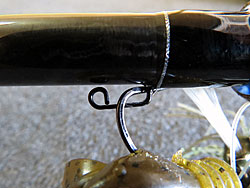
Add to this, there are zero obstructions, like a poorly placed hook hanger, to get in the way. That is moved to the bottom of the blank, behind the rear split grip. It’s also the style of hanger that allows you to leave your bait rigged weedless. You snap the hook in place, and voila, you’re done. It’s not a curved hook that the bait must be reeled up snug against to stay in place. It’s a spring, so it holds the bait in place during bumpy blast-offs come tournament time. No more tangled line in the rod box. I love that.
Speaking of grips, this is a split grip design, which I prefer. I like the looks of it, But it’s more than looks. This is a beefy fighting butt, made of hard EVA and burled cork. It’s nicely finished with color-keyed winding checks.
A quick mention of the guides – they’re not precisely micro guides, but they are much smaller than the typical guide I see on production rods. There’s a custom rod builder’s creed to use the smallest guide you can get away with and still let line and knots flow freely. This rod accomplishes that nicely. It is another feature integrated into the rod resulting from real-world angler input. I used 50-pound Seaguar Smackdown braided line. I had no issues wrapping around the guides with the braid like other rods. It was pretty refreshing. I own some other, very pricey rods that do not perform as well.

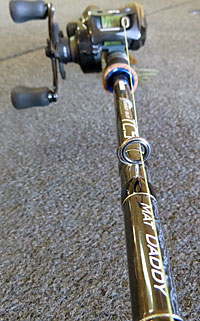
Let’s talk about the Cerros reel for a moment. This reel is affordably priced at $99.99 and has everything you would expect from a reel in that price range. It’s incredibly light and built with a rigid diecast aluminum frame and graphite side plates. It has a corrosion-resistant coating and an anodized aluminum spool. It features a multi-disk composite drag system, ten-ball bearings, quick-set anti-reverse roller bearing, and a 24-point adjustment on the cast control for precise settings.
While it does not have higher-end components found in reels priced at $200 and above, it is a workhorse nonetheless. I fished it ten days in a row, pitching into heavy cover with big jigs and plastics every day. I had no problem pitching. The reel was smooth and easy to adjust to my liking. Furthermore, it handily horsed big bass out of heavy cover repeatedly. The drag held on solid hooksets and felt smooth after I pulled bass away from the cover.
It has a click spool tension knob to adjust the friction on the spool shaft to control backlashes, which I prefer. The clicks, I feel, help “lock” the setting in place so I don’t have to mess with it every time I pick up the outfit. The low profile feels great in my hand. It performed well and looked great paired with the Mat Daddy TCS rod.
So, how do I wrap this up? Well, take the reel at MSRP of $99.99 and the rod at $149.99, add your favorite heavy cover line, and you’re out the door with a super flipping/pitching/punching/swimbait rod for the heaviest cover you can find for well under the $300 mark. With so much bass fishing becoming very expensive these days, this is a welcome change.
Thanks, Okuma and Scott Martin, for all the work, put into these products.

